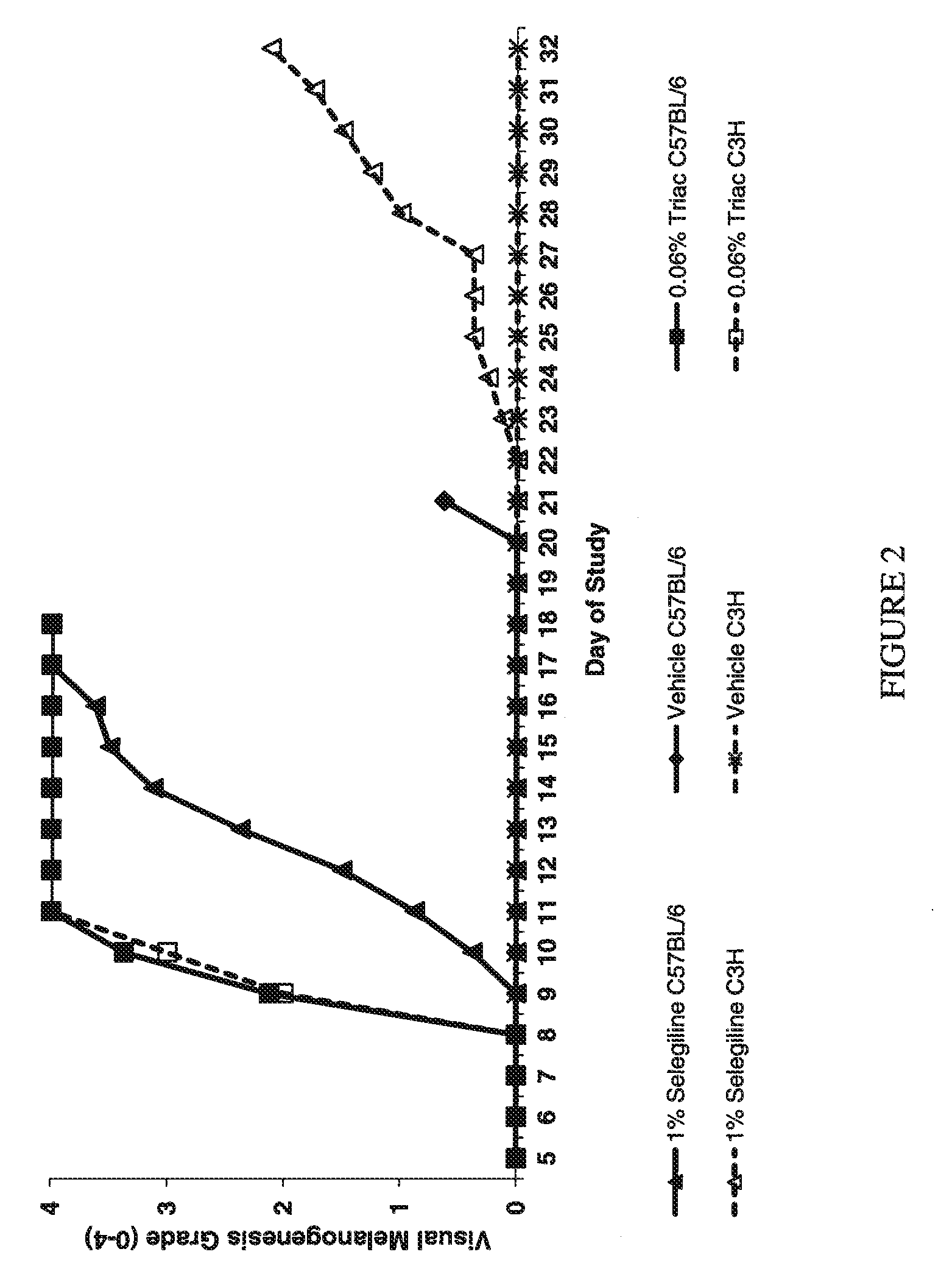Use of monoamine oxidase inhibitors to improve epithelial biology
a monoamine oxidase inhibitor and epithelial technology, applied in the direction of biocide, drug composition, hair cosmetics, etc., can solve the problems of thinning hair, significant hair loss, less attractiveness, etc., to improve epithelial biology, improve hair growth, reduce or delay the effect of hair and skin quality changes
- Summary
- Abstract
- Description
- Claims
- Application Information
AI Technical Summary
Benefits of technology
Problems solved by technology
Method used
Image
Examples
example 1
[0051]This example describes expression analysis of MAO in scalp and photo-aged skin
[0052]MAO expression and enzyme activity was studied in balding and non-balding human subjects. Higher levels of MAO gene expression also observed in balding individuals in comparison with non-balding individuals. In regions of balding scalp, MAOB levels were more about three-fold greater than MAOB levels observed in non-balding scalp, and were most pronounced in the vertex region compared to the occipital region. MAOB enzyme activity was observed in human hair-bearing skin. To confirm that MAOB correlates with reduced hair growth, MAOB production was studied in mice topically administered dihydrotestosterone (DHT), known to inhibit hair growth, and Triiodothyroacetic Acid (Triac), a hair growth inducer. MAOB levels increased greater than two fold in C57Bl / 6 mice administered DHT (12.5 mg / day using a subcutaneous, continuous release pellet). Reduced MAOB levels were observed following administration ...
example 2
[0055]This example describes a method of using MAO inhibitors to improve hair biology, in particular, hair growth, in vivo.
[0056]Several MAO inhibitors were tested for the ability to improve hair growth using the Telogen Conversion Assay (TCA) described in, e.g., International Patent Publication No. 2000 / 73265. The TCA utilizes C57Bl / 6 mice (Harlan Sprague Dawley, Inc., Indianapolis, Ind.), which exhibit synchronized hair growth, accompanied by melanogenesis, from approximately 40 days to 75 days following birth, to measure an agent's ability to convert follicles in telogen to anagen. The skin color of mice subjected to treatment is graded visually on a scale from zero to four (0=white skin; 1=light gray skin; 2=blue / black spots; 3=large blue / black region; 4=mostly blue / black skin). As a subject transitions from telogen to anagen, the skin color becomes darker.
[0057]Seven MAO inhibitors and two inactive metabolites of rasagiline were topically applied to C57Bl / 6 mice at the dosages ...
example 3
[0062]This example describes a method of improving hair growth by administering to a subject a MAO inhibitor and a vasodilator.
[0063]A vasodilator (minoxidil, 5%) was topically administered to C57Bl / 6 mice in combination with selegiline, lazebemide, rasagiline, clorgiline, or paragyline (1%), once daily for 19 days. Melanogenesis was evaluated as an indicator of hair growth using a visual scale of zero to four, as described in Example 1. The results of the study are illustrated in FIGS. 3 and 4. Administering selegiline with a vasodilator significantly improved hair growth beyond that observed following treatment with either compound alone (FIG. 3). The combination treatment accelerated the onset of hair growth compared to that observed with selegiline alone by up to two days. Combination treatment also increased the rate of hair growth in comparison to hair growth induced by minoxidil treatment alone. The results translate to an approximate 5-10% acceleration of hair growth inducti...
PUM
| Property | Measurement | Unit |
|---|---|---|
| size | aaaaa | aaaaa |
| weight | aaaaa | aaaaa |
| elasticity | aaaaa | aaaaa |
Abstract
Description
Claims
Application Information
 Login to View More
Login to View More - R&D
- Intellectual Property
- Life Sciences
- Materials
- Tech Scout
- Unparalleled Data Quality
- Higher Quality Content
- 60% Fewer Hallucinations
Browse by: Latest US Patents, China's latest patents, Technical Efficacy Thesaurus, Application Domain, Technology Topic, Popular Technical Reports.
© 2025 PatSnap. All rights reserved.Legal|Privacy policy|Modern Slavery Act Transparency Statement|Sitemap|About US| Contact US: help@patsnap.com



